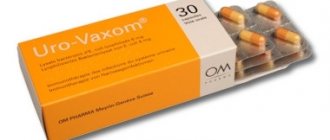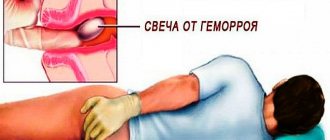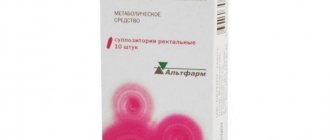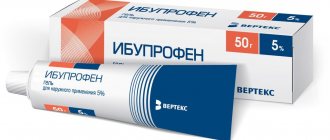Composition and release form
The medicine is available in several forms:
- pills;
- ointment;
- gel;
- candles;
- children's oral suspension.
The active substance is ibuprofen.
Auxiliary components in the tablets: potato starch, magnesium stearate, beeswax, sucrose.
Additional gel ingredients: ethanol, lavender oil, water.
Excipients in the ointment: macrogol.
Additional components of candles: solid fat.
Buy Ibuprofen-Altpharm rectal suppositories 60 mg No. 10 in pharmacies
Instructions for use Ibuprofen Buy Ibuprofen supp. rect. 60 mg No. 10 Dosage forms suppositories 60 mg, suppositories 60 mg Manufacturers Rofarma (Russia) Group Anti-inflammatory drugs - propionic acid derivatives Composition Active substance: Ibuprofen. International nonproprietary name Ibuprofen Indications for use:
For rectal use (children from 3 months to 2 years): as an antipyretic - acute respiratory infections, acute respiratory viral infections, influenza, other infectious and inflammatory diseases accompanied by an increase in body temperature; post-vaccination reactions. As an analgesic - pain of mild or moderate intensity (including headache and toothache, migraine, neuralgia, pain in the ears and throat, pain with sprains). ** Contraindications:
Hypersensitivity. For oral use: erosive and ulcerative diseases of the gastrointestinal tract in the acute phase (including peptic ulcer of the stomach and duodenum, Crohn's disease, ulcerative colitis, peptic ulcer), "aspirin" bronchial asthma, urticaria, rhinitis, provoked by taking salicylates or other NSAIDs; bleeding disorders (including hemophilia, hypocoagulation, hemorrhagic diathesis), optic nerve diseases, scotoma, amblyopia, color vision impairment, asthma, leukopenia, thrombocytopenia, hemorrhagic diathesis, confirmed hyperkalemia, severe liver failure or active liver disease, severe renal failure (creatinine clearance <30 ml/min), progressive kidney disease, severe heart failure, children up to 12 years of age (tablets, capsules, granules for solution), up to 6 years (effervescent tablets), up to 3 months (suspension for administration orally for children, rectal suppositories for children). For IV use: life-threatening infection, clinically significant bleeding (especially intracranial or gastrointestinal), thrombocytopenia or coagulation disorder, significant renal impairment, congenital heart disease in which a patent ductus arteriosus is a prerequisite for satisfactory pulmonary or systemic blood flow (eg pulmonary atresia, severe tetralogy of Fallot, severe coarctation of the aorta); diagnosed or suspected necrotizing enterocolitis. For external use: weeping dermatoses, eczema, violation of the integrity of the skin (including infected abrasions and wounds).
When to take medicine
The medicine in tablet form is effective for the following conditions:
- inflammatory processes in the spine and joints;
- moderate pain of various origins (menstrual, headache, toothache, pain after surgery);
- fever caused by a cold infection.
Gel and ointment should be used in the following cases: osteoarthritis, arthritis, gout and other diseases of the musculoskeletal system.
Suppositories and syrup are usually prescribed to children to reduce body temperature, for various childhood infections and to reduce pain (in the head, throat, ear).
How to take Ibuprofen
Pills
Adults and children over 14 years of age can be given no more than 4 tablets per day. Depending on the condition, the dose can be adjusted and increased to 6 tablets (the dose is divided into several doses). When improvement is noted, the dose should be reduced to the original. The first tablet should be taken in the morning before meals with a glass of water. Then take 1 tablet after meals.
Without consulting a doctor, tablets can be used for no more than 5 days.
Candles
The suppositories are placed rectally. For pain and fever, the dose is determined taking into account the age and body weight of the baby. You can use no more than 10 mg per 1 kg at a time. Candles can be lit up to 4 times per day. The optimal duration of use is 3 days. If suppositories are used as an analgesic, they can be administered for 5 days.
If after the allotted time the fever has not disappeared, then you should consult your pediatrician.
Gel
You can use a 5-9 cm strip of gel at a time. Using smooth, light movements, rub the gel into the problem area until the composition is completely absorbed. It is allowed to use the gel no more than 4 times per day, with repeated use no earlier than after 4 hours.
The duration of the treatment course can be 15-20 days.
Ointment
The scheme for using the ointment is in all respects similar to applying the gel. The drug is rubbed into the problem area of the skin 3-4 times a day. Can be used within 15-20 days.
Children's suspension
Ibuprofen in the form of a suspension can be given to a child no more than 3 times a day. If your child is under one year old, you should definitely consult a specialist before use. If the fever appears as a result of vaccination, then the suspension is given 2 times a day. There should be a break of at least 6 hours between doses.
Instructions for use IBUPROFEN
Inducers of microsomal oxidation (phenytoin, ethanol, barbiturates, rifampicin, phenylbutazone, tricyclic antidepressants) increase the production of hydroxylated active metabolites, increasing the risk of severe hepatotoxic reactions.
Microsomal oxidation inhibitors reduce the risk of hepatotoxicity. Reduces the hypotensive activity of vasodilators (including slow calcium channel blockers and angiotensin-converting enzyme inhibitors), natriuretic and diuretic activity of furosemide and hydrochlorothiazide. Reduces the effectiveness of uricosuric drugs, enhances the effect of indirect anticoagulants, antiplatelet agents, fibrinolytics (increasing the risk of hemorrhagic complications).
When interacting with mineralocorticosteroids. glucocorticosteroids, colchicine, estrogen, ethanol can cause an ulcerogenic effect with bleeding. Enhances the effect of oral hypoglycemic drugs and insulin. Antacids and cholestyramine reduce the absorption of ibuprofen. Increases the blood concentration of digoxin, lithium and methotrexate.
Caffeine enhances the analgesic effect of ibuprofen. When administered simultaneously, ibuprofen reduces the anti-inflammatory and antiplatelet effect of acetylsalicylic acid (an increase in the incidence of acute coronary insufficiency in patients receiving small doses of acetylsalicylic acid as an antiplatelet agent is possible after starting ibuprofen).
When prescribed with anticoagulant and thrombolytic drugs (alteplase, streptokinase, urokinase), the risk of bleeding simultaneously increases.
Cefamandole, cefaperazone, cefotetan, valproic acid, plicamycin increase the incidence of hypoprothrombinemia.
Myelotoxic drugs increase the manifestations of hematotoxicity of the drug. Cyclosporine and gold preparations enhance the effect of ibuprofen on the synthesis of Pg in the kidneys, which is manifested by increased nephrotoxicity.
Ibuprofen increases the plasma concentration of cyclosporine and the likelihood of developing its hepatotoxic effects.
Drugs that block tubular secretion reduce excretion and increase plasma concentrations of ibuprofen.
When using ibuprofen simultaneously with potassium-sparing diuretics, there is a risk of developing hyperkalemia; with other non-steroidal anti-inflammatory drugs - the risk of side effects from the gastrointestinal tract increases.
Contraindications and adverse reactions
Contraindications for all forms of medications include:
- stomach ulcers;
- problems with liver function;
- bearing a child (3rd trimester);
- internal bleeding;
- progressive kidney disease;
- chronic intestinal diseases;
- hypersensitivity to the constituent components.
It should be taken with caution for the following conditions and problems: liver cirrhosis, gastritis, stomach ulcers, problems with the cardiovascular system, liver and kidneys.
Children under 12 months can be given medicine only as prescribed by a doctor and under his supervision.
When using suppositories and tablets, the following adverse reactions may occur;
- irritation and dryness in the mouth;
- dyspnea;
- blurred vision;
- headache;
- confused thinking;
- disturbed sleep;
- high blood pressure;
- excessive sweating.
Ibuprofen supp rect det 60 mg x10
Ibuprofen supp rect det 60 mg x10, ATX code: M01AE01 (Ibuprofen) Active substance: ibuprofen (ibuprofen) Rec.INN registered by WHO
Dosage form
IBUPROFEN
Suppositories rect. (for children) 60 mg: 10 pcs.reg. No.: LP-000778 dated 09/29/11 - Valid
Release form, packaging and composition Ibuprofen
Rectal suppositories for children are white or almost white, smooth, torpedo-shaped.
1 sup.
ibuprofen 60 mg
Excipients: solid fat 516 mg.
Clinical-pharmacological group: NSAIDs Pharmaco-therapeutic group: NSAIDs
pharmachologic effect
NSAIDs. It has analgesic, anti-inflammatory and antipyretic effects.
The mechanism of action of ibuprofen is due to inhibition of the biosynthesis of prostaglandins - mediators of pain and inflammation. The effect of the drug lasts up to 8 hours.
Indications for Ibuprofen
Used in children from 3 months to 2 years of age as:
an antipyretic for acute respiratory diseases, influenza, childhood infections, post-vaccination reactions and other infectious and inflammatory diseases accompanied by an increase in body temperature, an anesthetic for pain of mild or moderate intensity, incl. headaches and toothaches, neuralgia, pain in the ears and throat, pain due to ligament damage and other types of pain. ICD-10 codes
Dosage regimen
Ibuprofen is a suppository specially designed for children. The drug is administered rectally.
Fever (fever) and pain: Dosage for children depends on the age and weight of the child. A single dose is 5-10 mg/kg of the child’s body weight 3-4 times/day. The maximum daily dose should not exceed 30 mg per kg of body weight of the child per day.
Children aged 3-9 months (5.5 kg-8.0 kg): 1 suppository (60 mg) 3 times within 24 hours every 6-8 hours, not more than 180 mg/day.
Children aged 9 months-2 years (8.0 kg-12.5 kg): 1 suppository (60 mg) 4 times within 24 hours after 6 hours, not more than 240 mg/day.
Post-immunization fever: 1 suppository for children under 1 year of age, after 1 year, if necessary, another suppository after 6 hours.
Duration of treatment:
no more than 3 days as an antipyretic, no more than 5 days as an analgesic.
If fever persists, consult your doctor. Do not exceed the indicated dose.
Side effect
When using the drug, side effects are rare, but the following side effects may occur:
From the gastrointestinal tract: nausea, vomiting, feeling of discomfort or pain in the epigastrium, laxative effect, possible occurrence of erosive and ulcerative lesions, bleeding.
Allergic reactions: skin rash, itching, urticaria, exacerbation of bronchial asthma, angioedema, anaphylactoid reactions, anaphylactic shock, bronchospasm, fever, erythema multiforme exudative (including Stevens-Johnson syndrome), toxic epidermal necrolysis (Lyell's syndrome).
From the nervous system: headache, dizziness, psychomotor agitation, insomnia.
From the cardiovascular system: tachycardia, increased blood pressure.
From the hematopoietic organs: anemia, thrombocytopenia, agranulocytosis, leukopenia.
From the urinary system: impaired renal function, cystitis.
If these or other side effects occur, stop using the drug and consult a doctor.
Contraindications for use
bronchial asthma, urticaria, rhinitis, provoked by taking acetylsalicylic acid (salicylates) or other NSAIDs, the presence of gastrointestinal ulcers in a child, active gastrointestinal bleeding, inflammatory bowel diseases, confirmed hypokalemia, blood diseases: hypocoagulation, leukopenia, hemophilia, renal and/or or liver failure, hearing loss, hypersensitivity to ibuprofen, acetylsalicylic acid or other NSAIDs, as well as to other components of the drug.
Carefully:
You should consult your doctor before using the drug if your child:
takes other painkillers, has a history of peptic ulcers, gastritis, ulcerative colitis, gastrointestinal bleeding, suffers from liver or kidney diseases, takes indirect anticoagulants (drugs for oral administration that reduce blood clotting), drugs to lower blood pressure, glucocorticosteroids, antiplatelet agents, diuretics (drugs to increase urination), lithium drugs, methotrexate, suffers from bronchial asthma, urticaria.
Use for liver dysfunction Use with caution in liver diseases. Contraindicated in liver failure.
Use for impaired renal function Use with caution in case of kidney disease. Contraindicated in renal failure.
Use in children Used in children from 3 months to 2 years of age
Overdose
Problems with overdose occur very rarely, but if you accidentally exceed the recommended dose, consult a doctor immediately.
Symptoms: abdominal pain, nausea, vomiting, headache, rapid eye movements (nystagmus), difficulty breathing, cyanosis of the lips and tip of the nose, bradycardia, tachycardia.
Drug interactions
The simultaneous use of Ibuprofen with anticoagulants can lead to an increase in their effect.
Ibuprofen increases the concentration of digoxin, phenytoin, methotrexate, lithium in the blood plasma when used simultaneously with these drugs.
Using ibuprofen with diuretics and antihypertensive drugs reduces their effectiveness.
Increases the side effects of mineralocorticosteroids and glucocorticosteroids.
Storage conditions Ibuprofen
The drug should be stored in a dry place, protected from light, at a temperature not exceeding 25°C. Keep out of the reach of children.
Shelf life Ibuprofen Shelf life - 2 years.
Terms of sale Without a prescription.







